
Wasps of the genus Sphex are cosmopolitan predators that sting and paralyze prey insects. Sphex is one of many genera in the old digger wasp family Sphecidae, though most apart from the Sphecinae have now been moved to the family Crabronidae. There are over 130 known Sphex species.

Pepsis is a genus of spider wasps belonging to the family Pompilidae.

Ammophila is the type genus of the subfamily Ammophilinae of the hunting wasp family Sphecidae. Ammophila is a large and cosmopolitan genus, with over 200 species, mostly occurring in the warmer regions of all continents apart from Antarctica.

Anoplius is a genus of spider wasps in the family Pompilidae, called the blue-black spider wasps.
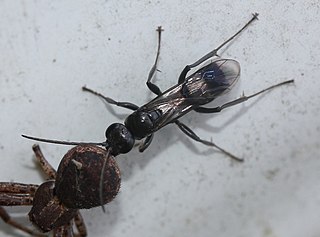
Dipogon is a genus of spider wasps of the family Pompilidae in the subfamily Pepsinae. They are found in Europe, Asia, and North America. Their generic name comes from the characteristic long bristle tufts just below the mandibles, which are used to carry material to construct the cells in the nest, and for constructing the nest.
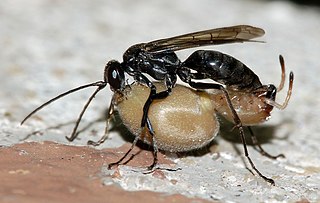
Auplopus is a large genus of spider wasps belonging to the subfamily Pepsinae of the spider wasp family Pompilidae, distributed throughout the world except for Antarctica. Auplopus wasps have the gruesome habit of amputating the legs of their spider prey before transporting it to the nest.
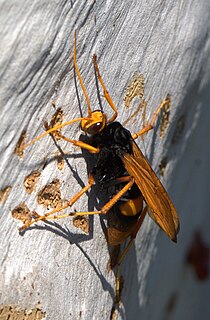
Cryptocheilus is a genus of spider wasps of the subfamily Pepsinae, they are found in the world's warmer regions. They vary in size from medium to large and are often strikingly coloured. The females construct multicellular nests in cavities, once built each cell is stocked with a spider, captured by the female. They are found in open habitats such as heaths, meadows and forest edges.

Ceropales is a genus of kleptoparasitic spider wasps from the sub-family Ceropalinae of the family Pompilidae. They are characterised by the taking of the spider prey of other solitary wasps, mainly Pompilidae but members of the Sphecidae that provision with spider prey are sometimes also hosts. In some languages their name translates into English as "cuckoo spider wasp".

Aporus is a genus of spider wasps from the family Pompilidae, they specialise in hunting ground dwelling spiders in their burrows for laying eggs on.

Evagetes is a genus of spider wasps from the family Pompilidae. There are 72 described species, of which 58 are found in the Palaearctic region, 11 in the Nearctic region, with a few penetrating to the Afrotropical, Oriental and Neotropic regions. Evagetes wasps are kleptoparasitic on other pompilid wasps, especially the genera Arachnospila, Anoplius, Episyron and Pompilus, digging into their sealed burrows, eating the host egg and replacing it with an egg of its own. Evagetes wasps are characterised by their very short antennae. Most are species are black with the base of the antennae rufous, several Evagetes species are very metallic bluish insects.
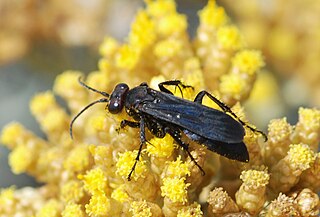
Agenioideus is a genus of spider wasps from the subfamily Pompilinae; the genus occurs in Europe, where 21 species are recorded, eastwards to Japan, in North America, South America, and Australia.

Caliadurgus is a genus of spider wasps of the subfamily Pepsinae. These are medium-sized black spider wasps with some red. They have a catholic habitat choice and their preferred prey are spiders of the families Araneidae and Tetragnathidae. They have a Holarctic and Neotropical distribution.
Priochilus is a genus of neotropical spider wasp in the family Pompilidae.

Cyphononyx is a genus of spider hunting wasps in the family Pompilidae.

Tachypompilus is a genus of spider wasps, found in the Neotropics Nearctic, eastern Palearctic, Indomalayan and Afrotropics.
Paracyphononyx is a genus of spider wasps distributed in the tropics and warmer temperate regions; they differ from other pompilids in that they do not permanently disable the host spider but allow the spider to resume activity after the wasp has laid its egg on the spider while the wasp larva exists as koinobiont ectoparasitoid of the spider.
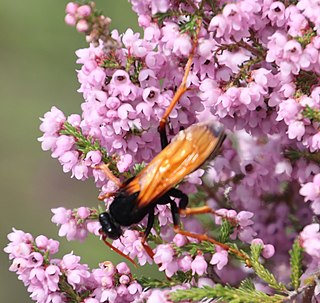
Hemipepsis is a genus of large pepsine spider wasps found throughout the tropics. They are commonly known as tarantula hawks. Hemipepsis wasps are morphologically similar to the related genera Pepsis and Entypus, but distinguishable by the pattern of wing venation. In South Africa 18 plant species from three plant families, the Apocynaceae, Orchidaceae, and Asparagaceae subfamily Scilloideae are pollinated exclusively by Hemipepsis wasps.

Psorthaspis is a genus of spider wasps in the family Pompilidae. There are more than 30 described species in Psorthaspis.
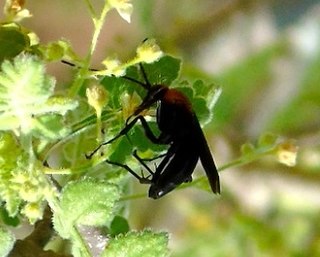
Notocyphus is a genus of spider wasps, belonging to the family Pompilidae. They are the only genus in the monotypic subfamily Notocyphinae. These wasps are found in the Nearctic and the Neotropics.
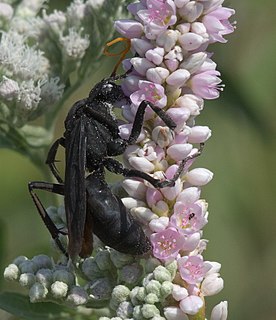
Entypus fulvicornis is a species of spider wasp belonging to the family Pompilidae. It is found in North America.



















